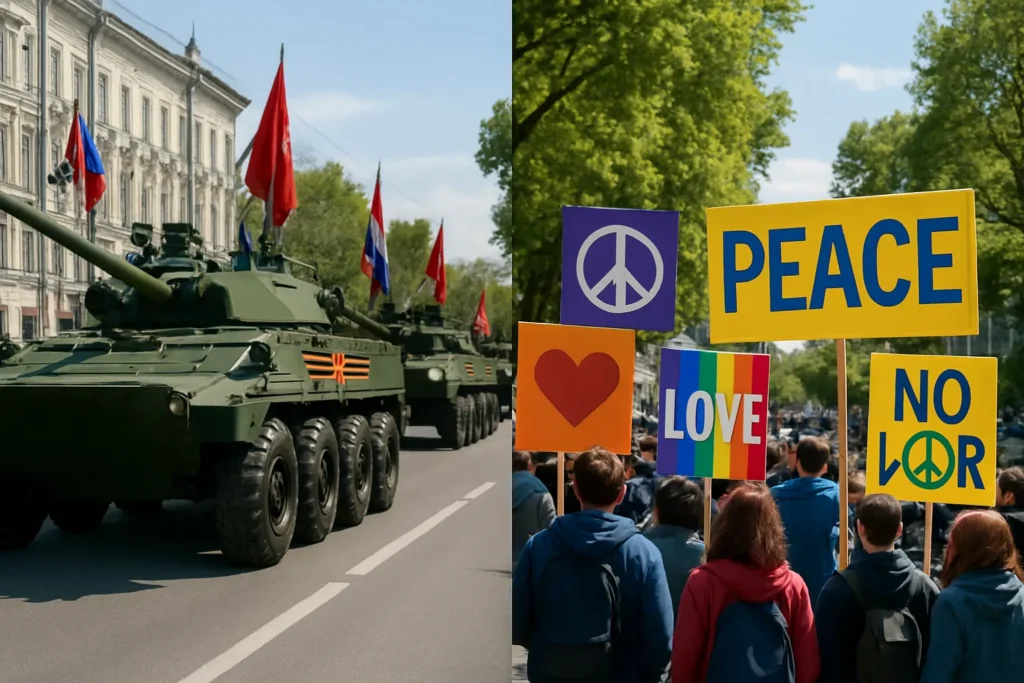Show of Force, Show of Dissent
Few days so vividly capture the fracture line running through modern America as June 14, 2025. On one end of Pennsylvania Avenue, the thundering spectacle of President Donald Trump’s military parade marked the U.S. Army’s 250th anniversary—replete with 6,600 uniformed service members, 50 helicopters slicing through stormy skies, and hulking 60-ton M1 Abrams battle tanks crawling past the White House. The event, doubling as a birthday bash for a president who has long admired authoritarian-style displays, cost an eye-watering estimate of $25 to $45 million, all billed to the American taxpayer (AP, Army Spokesperson, June 13).
Yet those gathered around the thunderous engines and waving flags in the capital were not alone in marking the day. Across more than 1,500 cities, millions took to the streets for the “No Kings” protests—organized by the 50501 Movement as a direct repudiation of what they call Trump’s “age of executive excess.” In York, Pennsylvania; Long Island, New York; Atlanta, Georgia; and on the sun-baked streets of Los Angeles, demonstrators carried handmade signs, their messages clear: “No Kings in America,” “Democracy Not Autocracy,” and “Families Over Force.” According to organizers, the aim of the movement echoes through its very name: 50 states, 50 protests, one message—power belongs with the people.
Reactions were as divided as the nation itself. Proponents of the parade called it a historic tribute to the Army’s formation—the moment in 1775 when a ragtag force united against tyranny. Critics, including civil rights advocates and many Democratic lawmakers, lambasted the spectacle as wasteful, militaristic, and a chilling echo of regimes America once opposed. “This kind of pageantry belongs in Moscow or Pyongyang, not the land of Lincoln,” said Representative Jamie Raskin (D-MD), capturing the prevailing mood among many progressives.
Defiance Beneath the Storms: Grassroots Pushback
A closer look reveals the intricate patchwork of coalition-building that propelled the 50501 Movement. Labors unions, immigration rights groups, and student organizers joined forces, galvanizing the day’s events into a decentralized, yet powerfully unified, challenge to both policy and pageantry. Nowhere was this more evident than in California, where anti-ICE rallies drew thousands despite the Trump administration’s controversial deployment of the National Guard and U.S. Marines—an act taken without the consent of Governor Gavin Newsom, sparking a fresh round of constitutional debate.
“Sending federal troops to intimidate peaceful protestors—especially against young DREAMers and immigrant families—is unconscionable and un-American,” charged community organizer Yesenia Alvarez, speaking to NPR from a rally in downtown Los Angeles. Her words echoed in cities nationwide where the threat of Immigration and Customs Enforcement raids lent the demonstrations an urgent, deeply personal edge. Purposeful, peaceful protest became the day’s refrain, as families marched with strollers and veterans hoisted faded signs from marches past.
“The American story is not one of crowns and cannons, but of constant vigilance from everyday people,” said author and historian Jill Lepore on MSNBC. “Every time the pendulum swings toward authoritarianism, it has always been the citizen who drags it back.”
Yet the drama was not without danger. In Minnesota, planned protests stood still in the wake of politically motivated shootings that left a former House Speaker and her husband dead and a senator and his wife hospitalized. With a suspected gunman still at large, organizers chose cancellation over risking further violence—a grim underscore of heightened tensions.
The Battle Over Symbols, Dollars, and Democracy
Why do lavish state displays and mass protests clash so viscerally in the American conscience? Harvard political scientist Daniel Ziblatt, co-author of “How Democracies Die,” offers an unsettling answer: When leaders use the military as political theater, it signals a retreat from the civilian control of government that defines true democracy. History, from Caesar’s Rome to Pinochet’s Chile, is riddled with cautionary tales.
Trump loyalists argue that such events boost national pride and military recruitment, echoing Pentagon officials who, according to The Washington Post, framed the parade as “an investment in the next generation of patriots.” Yet polling by Pew Research released just days before the spectacle found that 60% of Americans sided with the protestors—calling the parade an “inappropriate and unnecessary use of public money” while only 34% expressed strong approval.
Beyond that, the stark optics—armed vehicles on D.C. streets, while peaceful protestors brave rain and police lines—raised troubling questions about the direction of American values. How easily can an emphasis on martial pageantry edge into a normalization of strongman tactics? Constitutional scholars and civil rights advocates fear a permanent erosion of the unwritten norms that have kept raw power in check throughout centuries of American self-governance.
After the tanks have rolled away and damp protest signs are stored, one truth remains impossible to ignore: Political spectacle cannot paper over the nation’s deepest divides. Real unity comes only from recognizing that vibrant dissent, not obedient silence or costly parades, is the true measure of democratic health. Until the rhetoric of “No Kings” becomes reality, every presidential flourish—military or otherwise—will face the ultimate test not in the streets of Washington but in the hearts of Americans everywhere.

